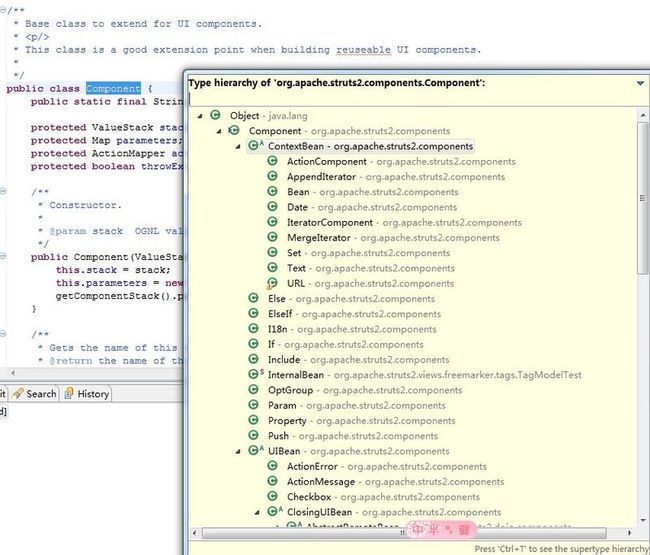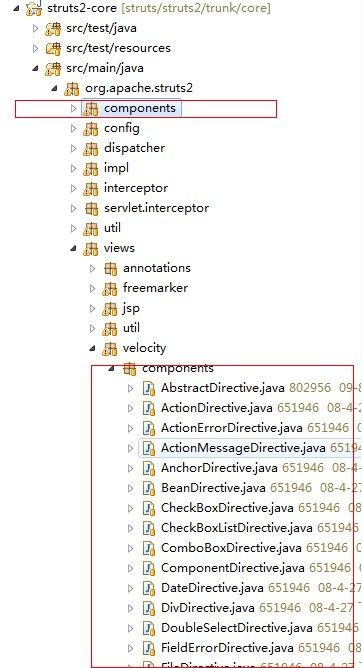struts2 与 velocity 整合 探究
我这边引出几个问题。
问题1,struts2 是怎么让 velocity 按照指定的 ResourceLoader 加载 vm 模板的?
首先,struts 默认的查找vm模板的路径有两种:
1,以 webapp 为相对路径下面去找
2,从 classpath 下面去找
那么看下面的代码 org.apache.struts2.views.velocity.VelocityManager:
- private void applyDefaultConfiguration(ServletContext context, Properties p) {
- // ensure that caching isn't overly aggressive
- /**
- * Load a default resource loader definition if there isn't one present.
- * Ben Hall (22/08/2003)
- */
- if (p.getProperty(Velocity.RESOURCE_LOADER) == null ) {
- p.setProperty(Velocity.RESOURCE_LOADER, "strutsfile, strutsclass" );
- }
这里就指明了 velocity.RESOURCE_LOADER 有两个,一个是 stutsfile, 一个是 strutsclass;
然后分别指明了 这两个 resource.loader 的详细参数如下:
- p.setProperty( "strutsfile.resource.loader.description" , "Velocity File Resource Loader" );
- p.setProperty("strutsfile.resource.loader.class" , "org.apache.velocity.runtime.resource.loader.FileResourceLoader" );
- p.setProperty("strutsfile.resource.loader.path" , context.getRealPath( "" ));
- p.setProperty("strutsfile.resource.loader.modificationCheckInterval" , "2" );
- p.setProperty("strutsfile.resource.loader.cache" , "true" );
- p.setProperty( "strutsclass.resource.loader.description" , "Velocity Classpath Resource Loader" );
- p.setProperty("strutsclass.resource.loader.class" , "org.apache.struts2.views.velocity.StrutsResourceLoader" );
- p.setProperty("strutsclass.resource.loader.modificationCheckInterval" , "2" );
- p.setProperty("strutsclass.resource.loader.cache" , "true" );
于是velocityEngine 引擎在初始化resource.loader 的时候就会初始化这2个loader 了。
那么,如果在开发阶段,不希望模板被cache ,能够修改完之后立马看到效果。可以在/WEB-INF/velocity.properties里面加上:
- strutsclass.resource.loader.cache = false
- strutsfile.resource.loader.cache = false
============================================================
问题2,struts2 怎么让 velocity 可以支持 layout ?
struts 2 自身带的velocityResult 是不支持 velocity 的layout的,它直接调用的是一个velocityEngine.如果需要它支持的话,需要仿照 velocity-tools中的
VelocityLayoutServlet 来重写 VelocityResult.
源代码请看附件
然后在struts.xml中进行配置
- < package name= "babystore" extends = "struts-default" abstract = "true" >
- <result-types>
- <result-type name="velocity" class = "com.yajun.babystore.common.struts.VelocityLayoutResult" default = "true" />
- </result-types>
- </package >
- <package name= "default" extends = "babystore" >
- <action name="HelloWorld" class = "helloWorldClass" >
- <result name="success" >/success.vm</result>
- </action>
- 。。。。。
参考: http://www.ibm.com/developerworks/cn/java/j-lo-struts2-velocity/index.html
============================================================
问题3,struts2 有哪些提供的方便的 tag,如何运用?
struts2 的tag 分为两种:
第一种 Generic Tag :http://struts.apache.org/2.2.1.1/docs/generic-tag-reference.html
第二种 UI Tags :http://struts.apache.org/2.2.1.1/docs/ui-tags.html
这些Tag 都是Component的子类如图:
那么这些Component 怎么和velocity ,freemarke 或者其他模板结合的呢? 我这里介绍和velocity结合的方式:
先看下图:
可以看到在velocity 这个包里面对上面的 component 都有对应的 类支持。
这些类都继承自org.apache.velocity.runtime.directive.Directive
这个类是用来实现类似velocity 中的 #set 这样的语法的(前面带个#号的那种)
注意到还有个基类:
- public abstract class AbstractDirective extends Directive {
- public String getName() {
- return "s" + getBeanName();
- }
发现在每个 beanName 前都加了个字符串s 。这就是为什么 velocity的模板中要用 #surl, #stext, #sform 的原因了。看到这段代码,也就不奇怪了。
那么知道了上面的东西之后,想看哪些tag 或者我叫做Component 的是常用的,或者怎么用,就看上面的源码吧。
问题4,struts2 如何支持 velocity-tools 的 toolbox ?
在struts.xml里配置
- <constant name= "struts.velocity.toolboxlocation" value= "/WEB-INF/toolbox.xml" ></constant>
然后再WEB-INF/toolbox.xml 下面加上:toolbox.xml
- <? xml version = "1.0" ?>
- < toolbox >
- < tool >
- < key > link </ key >
- < scope > request </ scope >
- < class >
- org.apache.velocity.tools.struts.StrutsLinkTool
- </ class >
- </ tool >
- < tool >
- < key > msg </ key >
- < scope > request </ scope >
- < class >
- org.apache.velocity.tools.struts.MessageTool
- </ class >
- </ tool >
- < tool >
- < key > errors </ key >
- < scope > request </ scope >
- < class >
- org.apache.velocity.tools.struts.ErrorsTool
- </ class >
- </ tool >
- < tool >
- < key > form </ key >
- < scope > request </ scope >
- < class >
- org.apache.velocity.tools.struts.FormTool
- </ class >
- </ tool >
- < tool >
- < key > tiles </ key >
- < scope > request </ scope >
- < class >
- org.apache.velocity.tools.struts.TilesTool
- </ class >
- </ tool >
- < tool >
- < key > validator </ key >
- < scope > request </ scope >
- < class >
- org.apache.velocity.tools.struts.ValidatorTool
- </ class >
- </ tool >
- </ toolbox >
问题5,struts 与 velocity 整合以后,有哪些内置的变量可以直接用?
- req - the current HttpServletRequest
- res - the current HttpServletResponse
- stack - the current OgnlValueStack
- ognl - an instance of OgnlTool
- ui - a (now deprecated) instance of a ui tag renderer

